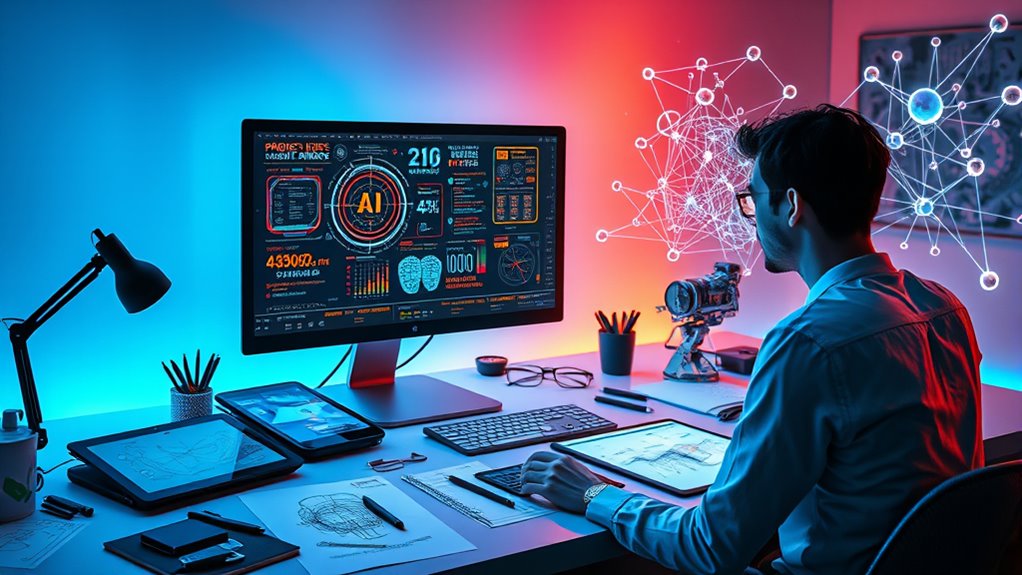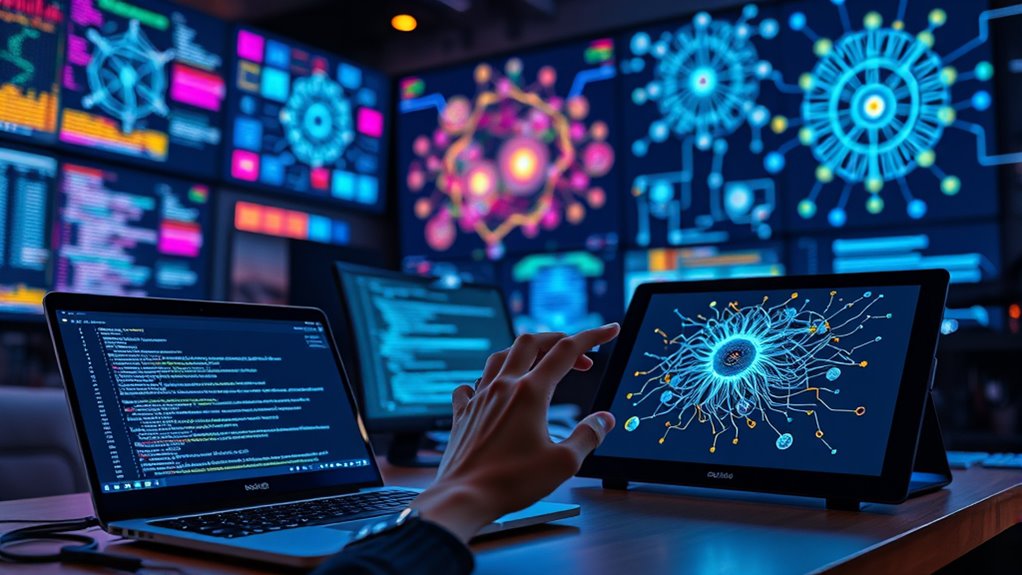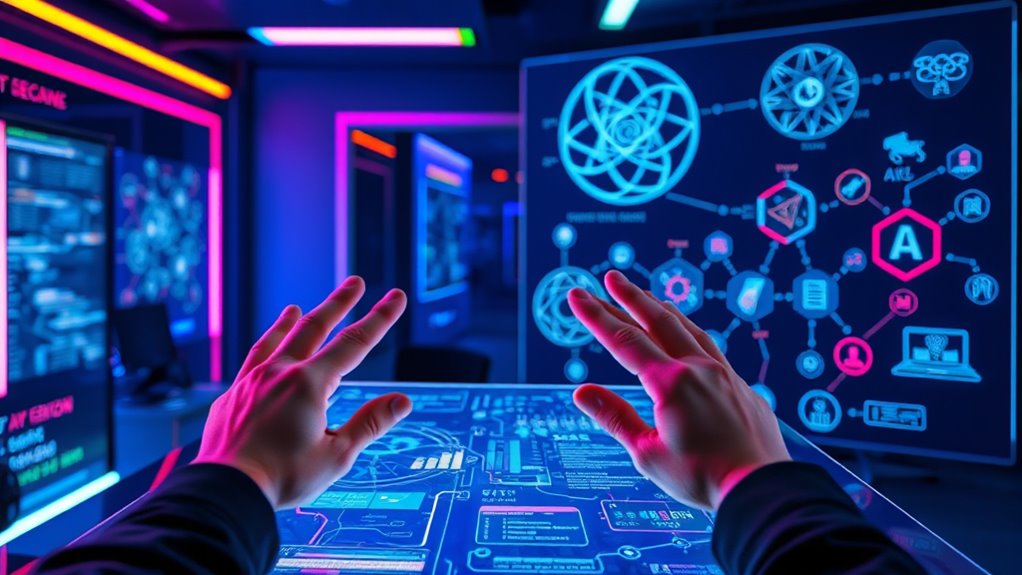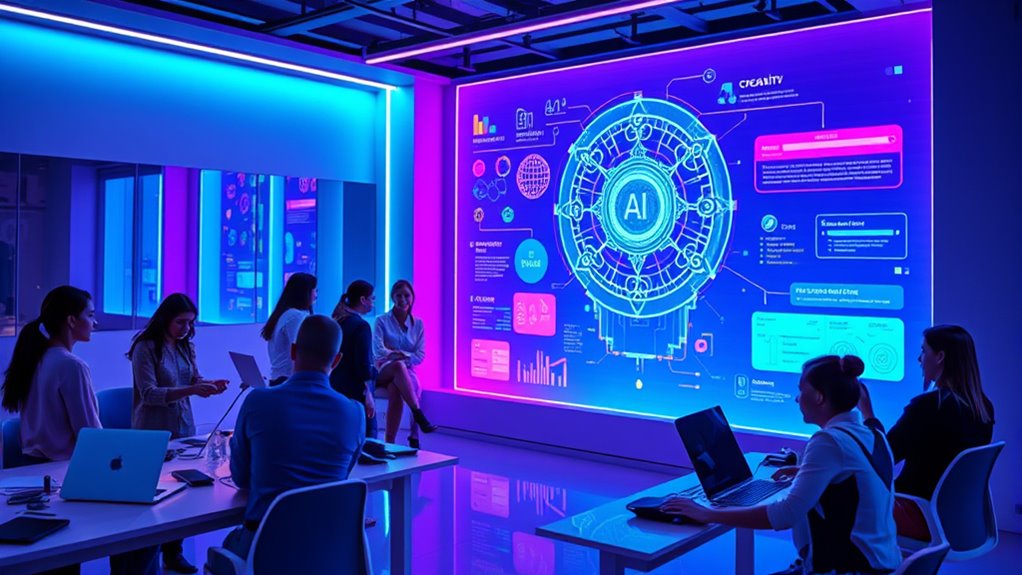The new creative economy is rapidly transforming with the rise of prompt engineering and AI roles, driving content creation, automation, and innovative workflows. You’ll find opportunities across sectors like healthcare, marketing, and education, where AI enables personalized and scalable content. As demand for skilled prompt specialists grows, mastering tools and ethical considerations becomes essential. To stay ahead, understanding the latest breakthroughs, challenges, and future trends will give you a competitive edge in this evolving landscape.
Key Takeaways
- Prompt engineering is a rapidly growing field vital to optimizing AI-driven content creation in the new creative economy.
- AI roles now include prompt designers, multimodal AI specialists, and ethical oversight professionals.
- The industry is experiencing exponential growth, with market value projected to reach trillions by 2034.
- Skills in prompt design, AI model understanding, and ethical practices are essential for new AI-driven creative careers.
- Collaboration between humans and AI tools fosters innovation, expanding creative possibilities and transforming traditional workflows.
The Growth Trajectory of Prompt Engineering Markets

The prompt engineering market is experiencing rapid expansion driven by the surge in generative AI technologies and increasing digitalization across industries. In 2024, its value is around USD 380 billion, with projections reaching approximately USD 6.5 trillion by 2034, growing at about 33% annually. Alternative estimates suggest a market size of USD 222 million in 2023, expected to hit USD 2.06 billion by 2030, with a CAGR of roughly 32.8%. This growth is fueled by advances in natural language processing, automation, and the adoption of large language models like GPT-4, Claude, and Llama. North America currently dominates the market share, but Asia Pacific is poised for the fastest growth, reflecting global digital transformation trends. Understanding the evolving role of emotional support in AI-driven interactions may further enhance user engagement and trust in these technologies.
Technological Breakthroughs Shaping Creative AI Workflows

Recent technological breakthroughs are revolutionizing creative AI workflows by enabling more sophisticated and automated prompt refinement. Advanced AI algorithms now evaluate millions of interactions, allowing you to access prompts dynamically based on user intent, sentiment, and context. Large language models like GPT-4, Claude, and Llama expand your capabilities, providing richer, more accurate responses. Multimodal AI models interpret text, images, audio, and video simultaneously, streamlining creative processes across media types. Unified AI frameworks manage multiple tasks—such as text-to-image or text-to-video generation—enhancing productivity and output quality. These innovations empower you to craft more precise prompts, automate tedious adjustments, and discover new creative possibilities. Additionally, understanding cost and budgeting considerations helps optimize resource allocation for AI-driven projects, ensuring sustainable and efficient workflows. As technology advances, you’ll find workflows becoming increasingly efficient, allowing for faster, more innovative content creation.
Key Sectors Benefiting From Ai-Driven Content Generation

You’ll find that healthcare benefits greatly from AI-driven content personalization, helping tailor treatments, patient education, and medical insights. In e-commerce, AI enables dynamic visual campaigns that attract customers and boost engagement efficiently. These sectors are just beginning to harness AI’s potential to transform their workflows and outcomes. Additionally, AI enhances predictive modeling in educational data mining, allowing institutions to proactively support students and optimize learning strategies.
Healthcare Content Personalization
As AI-driven content generation becomes more advanced, healthcare providers and organizations are increasingly leveraging personalized AI outputs to improve patient engagement and care. You can tailor health information, treatment plans, and follow-up advice based on individual needs and medical history. This enhances understanding, adherence, and satisfaction. AI prompts help create dynamic content like symptom explanations, medication guidance, and lifestyle suggestions. These tailored interactions make patients feel valued and understood, leading to better health outcomes. The importance of fathers’ influence in shaping confidence and health habits can also be reflected in personalized health messaging for families.
E-Commerce Visual Campaigns
How is AI transforming visual marketing campaigns in e-commerce? AI enables you to create highly personalized and engaging visuals at scale. It automates design, accelerates content production, and enhances customer targeting. Here’s what AI-driven e-commerce campaigns look like:
- Rapid generation of product images tailored to different demographics and styles.
- Dynamic ad visuals that adapt in real-time based on user behavior and preferences.
- Automated A/B testing of visual elements to optimize engagement and conversion rates.
- Multimodal content blending images, videos, and text seamlessly to tell compelling brand stories.
- Streamlined content creation and optimization processes facilitate faster deployment and more effective campaign adjustments.
This technology reduces costs, speeds up campaign deployment, and allows you to experiment with creative ideas effortlessly. AI empowers you to produce visually striking content that resonates with your audience and boosts sales.
The Evolving Job Landscape for Prompt Specialists

The job landscape for prompt specialists is rapidly transforming as AI technology advances and industries increasingly adopt generative models. You now find yourself in a dynamic field with expanding opportunities and shifting roles. Companies are actively seeking experts to optimize AI outputs, leading to high demand and competitive salaries. You might work at tech giants like Google or startups, or freelance on platforms earning $100–$300 per hour. As AI evolves, your skills in prompt design, multimodal inputs, and continuous learning become critical. The industry’s emotional impact is significant:
| Excitement | Challenge |
|---|---|
| Endless innovation | Staying ahead of rapid change |
| Creative empowerment | Navigating ethical concerns |
| High earning potential | Maintaining human oversight |
| Global opportunities | Adapting to new tools |
Essential Skills for Navigating the AI-Enhanced Creative Space

Exploring the AI-enhanced creative space requires a diverse set of skills that blend technical expertise with creative agility. To succeed, you need to master:
- Understanding AI model behavior and prompt design principles to craft effective inputs.
- Familiarity with machine learning basics and how AI systems interpret data.
- Creative problem-solving skills to develop industry-specific prompts that meet unique needs.
- Ability to handle multimodal inputs—text, images, audio, and video—to produce integrated outputs.
- Awareness of emerging AI applications, such as generative AI in entertainment, to leverage new content creation opportunities.
These skills help you adapt to rapidly evolving AI tools and ensure quality results. Continuous learning is essential, as AI models improve and prompt techniques advance. Staying versatile and technical allows you to thrive in the dynamic, AI-driven creative landscape.
Challenges in Implementing AI-Generated Content Responsibly

As organizations adopt AI-generated content more widely, they face significant challenges in ensuring responsible implementation. You need to address issues like bias, misinformation, and ethical use that can arise from unvetted AI outputs. Relying solely on AI risks amplifying harmful stereotypes or spreading false information if safeguards aren’t in place. You must establish clear guidelines for human oversight, ensuring content aligns with ethical standards and brand integrity. Transparency is essential—users should know when content is AI-generated, and you need to be prepared to correct errors quickly. Managing intellectual property rights and respecting privacy are additional concerns. Additionally, understanding the diverse designs of AI-generated content and their implications can help organizations better navigate these challenges. Ultimately, balancing innovation with responsibility requires ongoing monitoring, rigorous evaluation, and a commitment to ethical practices throughout your AI-driven content workflows.
Future Directions and Opportunities in AI-Driven Creativity

What new opportunities will AI-driven creativity reveal as technology continues to evolve? You’ll see transformative changes across industries, opening innovative avenues for creators. Consider these possibilities:
- Hyper-personalized Content: Tailoring experiences for individuals in real-time, enhancing engagement and relevance.
- Multimodal Creativity: Seamlessly blending text, images, audio, and video to produce rich, immersive media.
- Automated Ideation: Accelerating brainstorming and concept development through AI-generated suggestions and variations.
- Democratization of skills: Making sophisticated creative tools accessible to non-experts, broadening participation in content creation.
- The integration of AI in marketing strategies will further enable personalized and efficient content delivery.
As AI advances, you’ll have opportunities to push creative boundaries, develop new workflows, and reveal previously unimaginable ideas—all while improving efficiency and expanding your creative potential.
Ethical Considerations and Regulatory Frameworks in AI Roles

The rapid growth of AI roles, especially in prompt engineering, brings urgent ethical and regulatory challenges that cannot be ignored. You need to contemplate issues like bias, misinformation, and intellectual property, which can impact trust and fairness in AI outputs. As an AI user or developer, you must ensure transparency in how prompts influence results and be vigilant against unintended harm. Governments and industry bodies are beginning to develop frameworks to regulate AI deployment, emphasizing accountability and human oversight. You’ll also face the responsibility of adhering to evolving data privacy laws and ethical standards that protect user rights. Balancing innovation with ethical integrity is essential to foster public trust, prevent misuse, and ensure AI’s long-term positive impact in the creative economy. Moreover, understanding high refresh rates and their importance can help developers create more reliable and user-friendly AI-driven applications.
Preparing for a Collaborative Human-AI Creative Future

Preparing for a collaborative human-AI creative future involves not only technical skills but also fostering an imaginative mindset that embraces innovation and experimentation.
Frequently Asked Questions
How Does Prompt Engineering Impact Traditional Creative Professions?
Prompt engineering transforms traditional creative professions by streamlining workflows and expanding possibilities. You can generate content faster, customize outputs for specific needs, and explore new creative avenues with AI tools. It empowers you to focus on higher-level ideas while automation handles routine tasks. However, it also requires you to develop technical skills and adapt to evolving tools, blending creativity with technology to stay relevant in this changing landscape.
What Are the Key Ethical Concerns With Ai-Generated Content?
Think of AI-generated content as a double-edged sword—powerful yet perilous. Your key ethical concerns include authenticity, as it can blur lines between real and fabricated, risking misinformation. You also face issues of bias embedded in training data, which can perpetuate stereotypes. Respect for intellectual property is essential, and transparency about AI use ensures trust. Ultimately, you must balance innovation with responsibility to navigate AI’s creative frontier ethically.
How Can Non-Technical Individuals Leverage Prompt Engineering Skills?
You can leverage prompt engineering skills by learning to craft effective prompts, even without technical background. Use user-friendly AI tools and focus on understanding how to guide AI outputs through clear, specific instructions. Practice experimenting with different prompts to see what yields the best results. Stay updated on new techniques, join online communities, and collaborate with technical experts to improve your ability to harness AI creatively and efficiently.
What Standards Exist for Evaluating AI Prompt Effectiveness?
Think of evaluating AI prompts like tuning a musical instrument. You rely on standards such as accuracy, relevance, coherence, and creativity to judge effectiveness. Metrics like BLEU, ROUGE, and perplexity act as your tuning pegs, guiding improvements. Human feedback and industry benchmarks further refine your assessment. By applying these standards consistently, you guarantee your prompts produce harmonious, reliable AI responses that meet your creative or operational goals.
How Will AI Reshape Intellectual Property Rights in Creative Work?
AI will profoundly reshape intellectual property rights by creating new questions about ownership and originality. As you use AI tools to generate creative work, you’ll need to navigate whether rights belong to you, the AI developer, or the data sources. This evolving landscape demands clearer legal frameworks, emphasizing your role in guiding AI output while protecting your rights. Staying informed and adaptable ensures you can manage IP issues effectively in this changing environment.
Conclusion
As you step into this new creative landscape, think of yourself as a skilled captain steering uncharted waters. AI is the mighty vessel, propelling you forward, but your intuition and ethics are the steady compass guiding responsible exploration. Embrace the voyage, mastering the tools while respecting the horizon’s limits. Together, human ingenuity and AI can chart a course toward a vibrant, innovative future where creativity knows no bounds.









